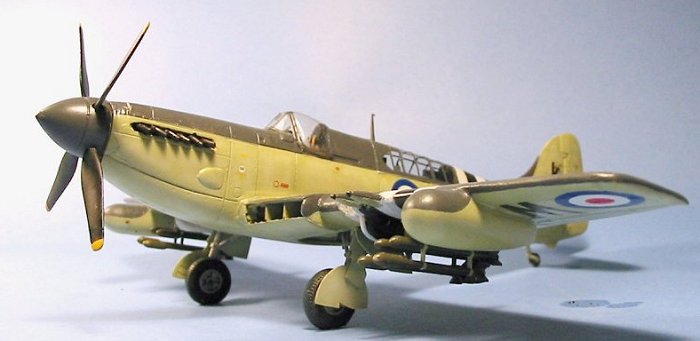
|
KIT: |
PP Aeroparts 1/48 Firefly FR.5 |
|
KIT # |
? |
|
PRICE: |
$45.00 MSRP in 1994 |
|
DECALS: |
two options |
|
REVIEWER: |
Tom Cleaver |
|
NOTES: |
Vacuformed multimedia kit |

|
HISTORY |
During the last year of the Second World War, the Fairey Firefly F.R.I had proven itself the best British-designed carrier strike aircraft used in the conflict. With the end of the war and the need to get rid of the U.S. carrier aircraft provided under lend-lease, the Firefly acquired new importance as it became the only carrier-based strike aircraft available to the Fleet Air Arm.
After the design and production of the Firefly III, a Mk.I airframe with a Griffon 61 engine enclosed in an annular radiator that made the aircraft directionally unstable, a more extensive redesign around the more powerful engine was undertaken. The radiators were removed to the leading edges of the wing, which allowed a much cleaner engine cowling, with benefit to both performance and handling. Trials with the original Firefly III airframe with the new cowling and radiator installation began in 1944, with the engine upgraded to a Griffon 72. Three more Mk.I airframes were used in the development program, which resulted in the Firefly IV.
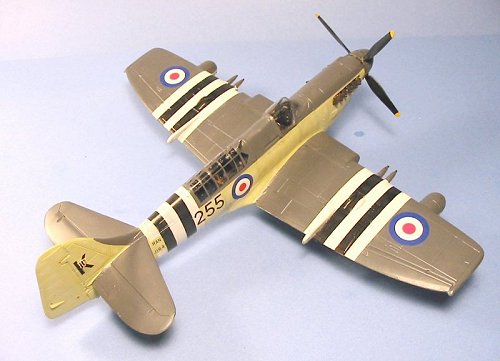 The new
version used the Griffon 74, which proved 2,100 h.p. at sea level,
compared with the 1,735 h.p. available from the Griffon II and XII used
in the Firefly I. This allowed the maximum weight to be raised 1,000
pounds above that of the Mk.I, and still provide a 40 m.p.h. increase in
maximum speed, to 345 m.p.h. at 12,500 feet. The wingtips were clipped
to improve the roll rate, though the total wing area remained the same
with the increase at the wing roots for the radiators, and the ASH radar
used by the N.F.I was located in a small nacelle under the starboard
wing, with an auxiliary fuel tank of similar size and shape under the
port wing to preserve symmetry. Flight tests in 1945 revealed a need for
a 4-blade prop to absorb the increased power and an enlarged vertical fin
and rudder to preserve stability.
The new
version used the Griffon 74, which proved 2,100 h.p. at sea level,
compared with the 1,735 h.p. available from the Griffon II and XII used
in the Firefly I. This allowed the maximum weight to be raised 1,000
pounds above that of the Mk.I, and still provide a 40 m.p.h. increase in
maximum speed, to 345 m.p.h. at 12,500 feet. The wingtips were clipped
to improve the roll rate, though the total wing area remained the same
with the increase at the wing roots for the radiators, and the ASH radar
used by the N.F.I was located in a small nacelle under the starboard
wing, with an auxiliary fuel tank of similar size and shape under the
port wing to preserve symmetry. Flight tests in 1945 revealed a need for
a 4-blade prop to absorb the increased power and an enlarged vertical fin
and rudder to preserve stability.
A reallocation of contracts for Firefly Is in August 1945 allowed for initial production of 30 F.R. Mk.IV and 23 N.F. Mk.IV Fireflies, with a further 67 F.R. Mk.IVs ordered in November for a total production of 120 aircraft for the Fleet Air Arm. In May, 1946, the Royal Netherlands Navy ordered 40 F.r. Mk.IVs.
While the first flight of a production Firefly IV came on May 25, 1945, the wind-down of the war resulted in the first Mk.IV being delivered in September 1946, with the first two fleet squadrons - 810 and 825 - becoming operational in September 1947.
While the Firefly IV joined the earlier Firefly Is in fleet squadrons in the fighter-reconnaissance role, the visually virtually-identical Firefly 5 became a "universal" airframe which could be used in either the fighter-reconnaissance or anti-submarine role. First flight of the Firefly V came on December 12, 1947. An outstanding contract for 117 Firefly IVs was modified to cover initial production of the Firefly 5, with subsequent production of 52, 103 and 66 aircraft beginning in May 1948; Dutch purchase of an additional 14 Firefly 5s brought total production to 352, with delivery to the FAA beginning in January 1948 and ending in May 1950.
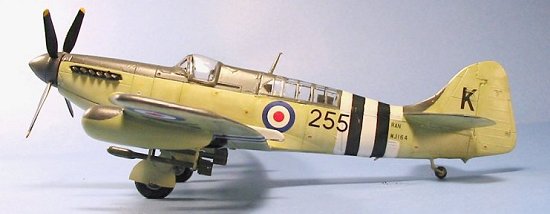 FAA squadrons
using the Firefly I began re-equipping with the Firefly 5 with 815
squadron taking the first on charge in late January 1948. No. 825
Squadron took on seven Firefly 5s in addition to their 24 Firefly 4s, and
operated from HMCS "Magnificent" as an RCN squadron. 816 and 817
Squadrons, both completely equipped with Firefly 5s, served with the
Royal Australian Navy aboard HMAS "Sydney."
FAA squadrons
using the Firefly I began re-equipping with the Firefly 5 with 815
squadron taking the first on charge in late January 1948. No. 825
Squadron took on seven Firefly 5s in addition to their 24 Firefly 4s, and
operated from HMCS "Magnificent" as an RCN squadron. 816 and 817
Squadrons, both completely equipped with Firefly 5s, served with the
Royal Australian Navy aboard HMAS "Sydney."
The Firefly's major combat operations came with the outbreak of the Korean War. Firefly Is of 827 Squadron were aboard HMS "Triumph" when it entered combat in July 1950. The first Firefly 4 squadron to see combat was 810, aboard HMS "Theseus", which relieved "Triumph" in October 1950. The Firefly 4s and 5s operated from the light fleet carriers in Korean waters primarily flew close support missions for the ground troops. This was not a mission originally envisaged for the aircraft, but the ability of the Firefly 4s and 5s to carry significant underwing ordnance loads due to the extra power of the Griffon 74 allowed a combat load of 2,000 lbs. per aircraft. While this was light compared to such U.S. types as the Corsair and Skyraider, it was a significant load to be taken off one of the small British light carriers, without aid of a catapult. The aircraft was so reliable it could fly up to 120 sorties per day from a carrier, with a squadron of 26 aircraft, often in extremely adverse weather.
The record
number of 123 sorties flown in a single day by H.M.S. "Ocean" on May 17,
1952, included 47 by 825
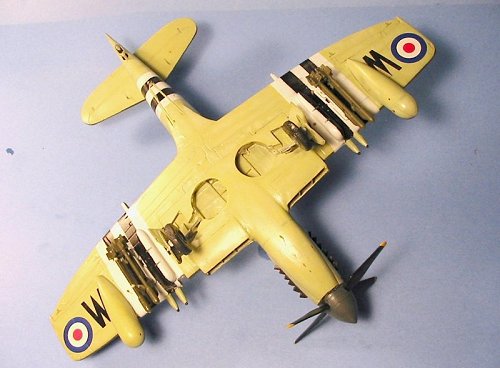 Squadron's Fireflies. At the end of July, 1952,
MiG-15s first attacked the unit's aircraft, causing one Firefly to
force-land. Between May and the end of October 1952, 825 Squadron flew
1,907 sorties in 3,243 flying hours; in 1,948 deck landings, there were
only four accidents. 16,868 rockets were fired and 96,500 pounds of
bombs dropped. For this performance, 825 was awarded the Body Trophy for
1952. The end of the war in Korea saw the end of combat service for the
Firefly, which had seen the units sent to Korea also used while enroute
to and from the war zone for strikes in Malaya in support of Operation
Firedog, the anti-terrorist war which had begun in 1948. The active
first-line service of the Firefly with the Royal Navy ended in 1956,
though Fireflies modified as trainers, tugs and targets operated until
1964.
Squadron's Fireflies. At the end of July, 1952,
MiG-15s first attacked the unit's aircraft, causing one Firefly to
force-land. Between May and the end of October 1952, 825 Squadron flew
1,907 sorties in 3,243 flying hours; in 1,948 deck landings, there were
only four accidents. 16,868 rockets were fired and 96,500 pounds of
bombs dropped. For this performance, 825 was awarded the Body Trophy for
1952. The end of the war in Korea saw the end of combat service for the
Firefly, which had seen the units sent to Korea also used while enroute
to and from the war zone for strikes in Malaya in support of Operation
Firedog, the anti-terrorist war which had begun in 1948. The active
first-line service of the Firefly with the Royal Navy ended in 1956,
though Fireflies modified as trainers, tugs and targets operated until
1964.
The Firefly was not a great warplane, but it was a thoroughgoing workhorse with extraordinary versatility and tractability, which had been able to take on missions unforeseen at the time of its initial design in 1939.
|
THE KIT |
Grand Phoenix brought out a Firefly I in 2002, and a Firefly 4/5 has been rumored ever since. At present, however, the only 1/48 Firefly available is a vacuform from P-P Aeroparts which is no longer in production, and a full-resin kit developed from the vacuform by the same company, which is also out of production, though I believe it may still be available from Hannant's. The only other late version Firefly to have been released as a kit is the elderly Airfix offering in 1/72, which can be made up into an acceptable model with a considerable application of "some modeling ability required."
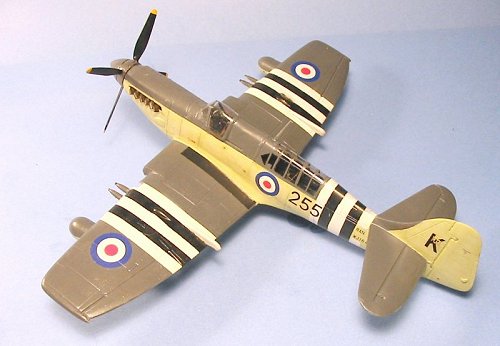 As someone who
appreciates the aircraft of the Fleet Air Arm, I bought one of the
vacuform Fireflies back in 1994 when they first became available here in
the U.S. from Precision Enterprises. The kit is a primitive vacuform in
comparison with those released by Dynavector, with some real "trenches"
for panel lines, canopies thick enough that opening them would mean
making a vacuform from the vacuform, resin cockpit and gear well tubs,
supplemented with photo-etch detail parts for seats, etc. However, if
one wanted a 1/48 Firefly, this was the game. The decals were some of the
best limited-run English decals I have seen (most of the time,
English-made decals remind me of Lucas electrical systems, another item
that makes me wonder how they ever invented the Industrial Revolution).
As someone who
appreciates the aircraft of the Fleet Air Arm, I bought one of the
vacuform Fireflies back in 1994 when they first became available here in
the U.S. from Precision Enterprises. The kit is a primitive vacuform in
comparison with those released by Dynavector, with some real "trenches"
for panel lines, canopies thick enough that opening them would mean
making a vacuform from the vacuform, resin cockpit and gear well tubs,
supplemented with photo-etch detail parts for seats, etc. However, if
one wanted a 1/48 Firefly, this was the game. The decals were some of the
best limited-run English decals I have seen (most of the time,
English-made decals remind me of Lucas electrical systems, another item
that makes me wonder how they ever invented the Industrial Revolution).
I built the airplane without much difficulty, and over the years it sat on the shelf with the rest of my Fleet Air Arm collection. And, over the years, it suffered its share of dings and bangs being moved around. As well, it was a model from before the time I discovered the Internet, which meant that it was no longer up to my "current abilities" in terms of its look. When the Grand Phoenix kit came out, I thought there would be a Firefly 4/5 relatively soon, given the sales records of the first kit, and was thinking of donating the vacuform to the Planes of Fame model museum, with some touching-up. However, it became apparent that any release of the late-version Firefly from Grand Phoenix was going to be at some unnamed future date, so I decided that the model was worthy of restoration, since the basic construction was still sound.
|
RESTORATION |
I have
frequently over the years found myself restoring models, where the basic
kit is soundly built, but there have been new offerings of more
interesting markings, etc., where my skills have improved, and where the
kit itself may no longer be available should I want to replace the
original model. Given the cost of kits these days, restoring an older
but well-built model can make a great deal of economic sense.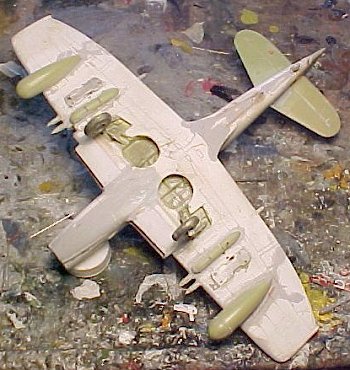
Restoration started with my removing all the small detail parts and landing gear. The white metal parts were all put into a clean cat food can and then bathed in some ELO to remove the paint. I also removed the vacuform canopies and dipped them in the ELO. Once they were clean, the canopies were dipped in Future and suddenly became the clear, good-looking parts they should have always been.
With all the little parts off, I "painted" the model with ELO, and removed the paint. As I did so, I became aware that there were items of finish that could be re-done to a superior standard, now that my toolbox included such things as Mr. Surfacer. After cleaning off the model, I applied Mr. Surfacer to all the seams and joints, and did a general restoration of the overall surface of the model. It was beginning to look much better.
I cleaned up the cockpits, and added some additional detail. Since they are both finished in interior black, this is mostly hard to see in photographs, though the cockpits now look good seen through the clear canopies. I reattached the canopies and masked them off, and the model was ready for the paint shop.
|
CAMOUFLAGE & MARKINGS |
I pre-shaded
the model as I do nowadays, then painted and masked off the black and
white "D-Day stripes," since I was doing a Korean-era airplane. The
lower surfaces were then painted with Gunze-Sangyo "Sky", which is a
different color from Tamiya "Sky," and correct for the post-war shade.
That was masked off after I had "faded" the
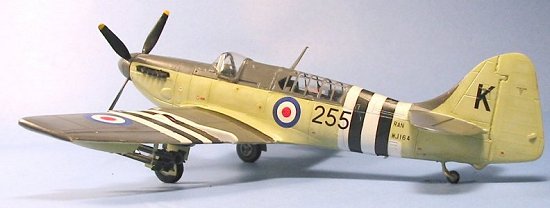 lower color after
adding white to the original paint. I masked that off and painted
the upper surfaces with Tamiya XF-24 Dark Grey, which is a good match for
Dark Sea Grey. This was also "faded." When that was dry, the model
was unmasked and given an overall coat of Future.
lower color after
adding white to the original paint. I masked that off and painted
the upper surfaces with Tamiya XF-24 Dark Grey, which is a good match for
Dark Sea Grey. This was also "faded." When that was dry, the model
was unmasked and given an overall coat of Future.
Decals:
I didn't have any way of obtaining another sheet of the original decals, and there are no 1/48 aftermarket sheets available for the Firefly 4/5. I ended up going through the Decal Dungeon to obtain national insignia, numbers and letters, and some stencilling, to make up a Firefly 5 of 816 Squadron, Royal Australian Navy, serving aboard HMAS "Sydney" in Korea during 1953.
|
FINAL CONSTRUCTION |
I re-attached the propeller and the landing gear, and armed the model with 60-lb RPs taken from the spares box after coming out of an Airfix Spitfire 24 kit. Exhaust stains were created with Tamiya "Smoke."
|
CONCLUSIONS |
Pending the arrival of the Grand Phoenix Firefly 4/5 kit whenever that happens, I now have a "state of my art" Firefly 5 in my Fleet Air Arm collection, and a model that was quite expensive when originally purchased (and would still be so today) has been saved. It looks far better now than its original finish, which is proof to me that I continue to add to my skill and technique in this hobby - which to me is what it's all about.
November 2003
Review kit courtesy of my wallet.
If you would like your product reviewed fairly and quickly by a site that has over 200,000 visitors a month, please contact me or see other details in the Note to Contributors.